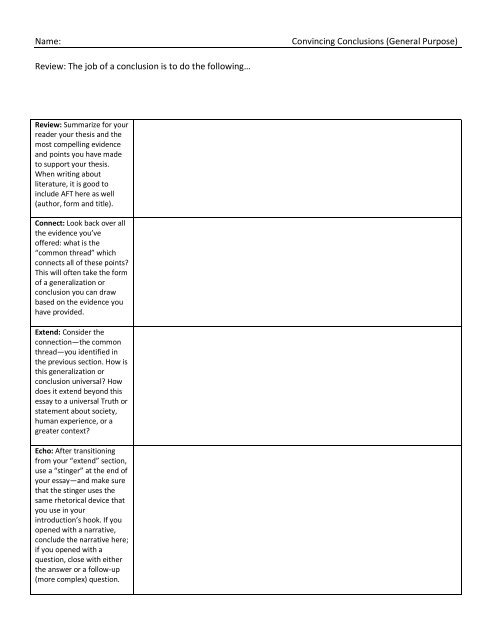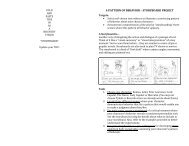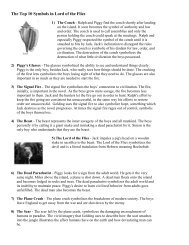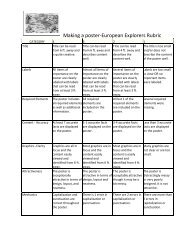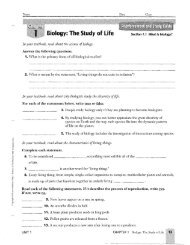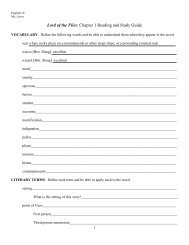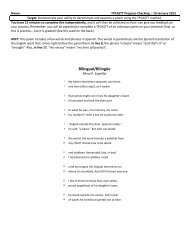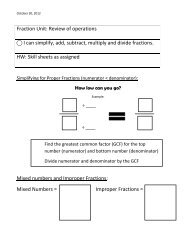General Conclusion form (.pdf)
General Conclusion form (.pdf)
General Conclusion form (.pdf)
Create successful ePaper yourself
Turn your PDF publications into a flip-book with our unique Google optimized e-Paper software.
Name: Convincing <strong>Conclusion</strong>s (<strong>General</strong> Purpose)<br />
Review: The job of a conclusion is to do the following…<br />
Review: Summarize for your<br />
reader your thesis and the<br />
most compelling evidence<br />
and points you have made<br />
to support your thesis.<br />
When writing about<br />
literature, it is good to<br />
include AFT here as well<br />
(author, <strong>form</strong> and title).<br />
Connect: Look back over all<br />
the evidence you’ve<br />
offered: what is the<br />
“common thread” which<br />
connects all of these points?<br />
This will often take the <strong>form</strong><br />
of a generalization or<br />
conclusion you can draw<br />
based on the evidence you<br />
have provided.<br />
Extend: Consider the<br />
connection—the common<br />
thread—you identified in<br />
the previous section. How is<br />
this generalization or<br />
conclusion universal? How<br />
does it extend beyond this<br />
essay to a universal Truth or<br />
statement about society,<br />
human experience, or a<br />
greater context?<br />
Echo: After transitioning<br />
from your “extend” section,<br />
use a “stinger” at the end of<br />
your essay—and make sure<br />
that the stinger uses the<br />
same rhetorical device that<br />
you use in your<br />
introduction’s hook. If you<br />
opened with a narrative,<br />
conclude the narrative here;<br />
if you opened with a<br />
question, close with either<br />
the answer or a follow-up<br />
(more complex) question.
Example Introductions and <strong>Conclusion</strong>s: Label the key parts of each…<br />
Introduction: Hook, Bridge, Synopsis, Thesis<br />
<strong>Conclusion</strong>: Review, Connect, Extend, Echo<br />
Private First Class Paul Berlin could<br />
only hear the thunder of his own heartbeat<br />
in his ears. The vivid images bombarded<br />
his mind: the explosion, the blood, the<br />
smoke, the fire. Berlin had no idea the<br />
reaction that this memory would bring out<br />
in him. In Tim O’Brien’s Vietnam war<br />
short story “Where Have You Gone,<br />
Charming Billy?” PFC Berlin experiences<br />
his first few days in country. On his first<br />
day, he watches a man die not of warfare,<br />
but of a fear-induced heart attack. Berlin<br />
retreats into his memories and daydreams<br />
to cope with his fear, but the irony of Billy<br />
Boy Watkins’s death is too much for PFC<br />
Paul Berlin. Berlin’s reaction to Watkins’s<br />
death illustrates the irony of war and how<br />
during war, fear becomes a paradox.<br />
Life and blood are inseparable concepts.<br />
Without blood coursing through one’s<br />
veins, life cannot be sustained. However, in<br />
William Shakespeare’s tragic play<br />
Macbeth, blood represents not life, but<br />
something more sinister. Set in Scotland,<br />
Macbeth chronicles the misguided efforts<br />
of Macbeth, a thane (like a duke), who is<br />
prompted by the prophesies of three<br />
strange witches and the ambition of his<br />
wife to murder King Duncan in order to<br />
become King himself. However, as in all<br />
tragedies, things do not go according to<br />
plan. After murdering Duncan, both<br />
Macbeth and Lady Macbeth experience<br />
crippling guilt that ends them. This guilt is<br />
symbolized throughout the play by<br />
Shakespeare’s blood imagery.<br />
While at war, PFC Paul Berlin in Tim<br />
O’Brien’s short story “Where Have You<br />
Gone, Charming Billy?” reveals the paradox<br />
of wartime fear by laughing hysterically at<br />
the absurdity of Billy Boy’s death. Berlin’s<br />
very obsession with fear turns ironic when it<br />
is that very fear, not a bullet or bomb, which<br />
ends up taking Billy Boy’s life. Berlin’s two<br />
reactions, first daydreaming and then<br />
unstoppable laughter, illustrate an attempt to<br />
cope with the paradoxical ironies inherent in<br />
war. Ultimately, fear underlies both of these<br />
reactions, showing fear can inspire<br />
unexpected and even contradictory<br />
responses. As the fear overtakes PFC Paul<br />
Berlin, laughter overtakes him as well. The<br />
supreme irony of dying from fright while a<br />
soldier in a war zone sends him into<br />
hysterics. But when the laughter stops, the<br />
fear remains.<br />
In Shakespeare’s Macbeth, the guilt that<br />
both Macbeth and his wife feel for the<br />
murder of King Duncan is overwhelming—<br />
and Shakespeare symbolizes this guilt<br />
through imagery of blood. Through all these<br />
examples, the blood serves as a constant<br />
reminder of Macbeth’s and Lady Macbeth’s<br />
actions, literally staining them with guilt.<br />
This symbolic guilt is visible only to the<br />
guilty parties themselves. Through his<br />
torment of Macbeth and Lady Macbeth,<br />
Shakespeare uses the blood symbolism to<br />
illustrate how guilt can stain a human being<br />
permanently, forever coloring their<br />
existence from the moment of the offense<br />
onward. In effect, then, life and blood are<br />
still in fact inseparable concepts in this play.<br />
However, in Shakespeare’s view, it is not<br />
that blood is life-giving, but that blood on a<br />
guilty hand can be life-staining.


